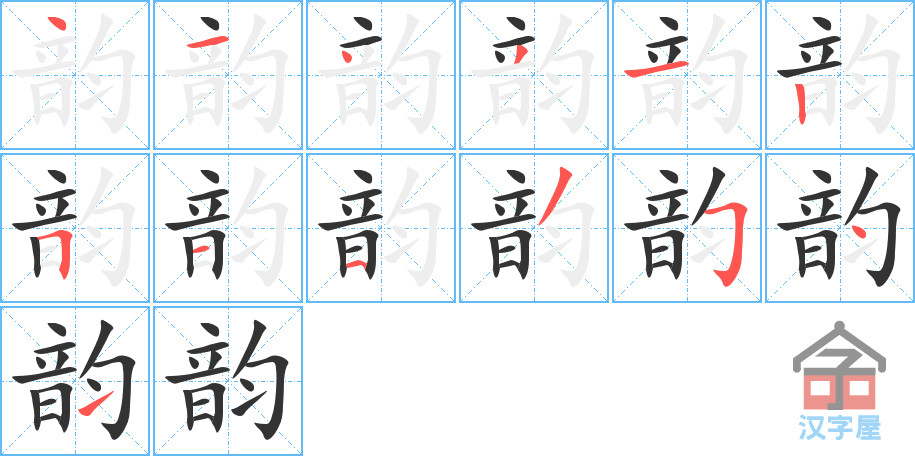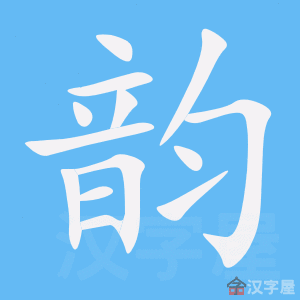Character
| HSK | Not in HSK |
|---|---|
| FREQUENCY | 2501st character |
| RADICAL | ⾳ (180.4) |
| STROKES | 13 |
| INDEX # | 2995 |
| TRADITIONAL | 韻 |
rhyme; vowel
#2501
DEFINITIONS
- rhyme
- vowel
- beautiful sound
- appeal
- charm
- vowel
- rhyme
- in Chinese phonetics, the medial and final sound of a syllable (i.e. excluding the initial consonant)
STROKES


WORDS
| 押韵 yā yùn | to rhyme; sometimes written 壓韻|压韵 |
| 韵事 yùn shì | poetic occasion; elegant situation; in literature, the cue for a poem |
| 韵律 yùn lǜ | cadence; rhythm; rhyme scheme; meter (in verse); (linguistics) prosody |
| 韵味 yùn wèi | implicit charm in rhyme or sound; hinted appeal; interest |
| 压韵 yā yùn | variant of 押韻|押韵[ya1 yun4] |
| 风韵 fēng yùn | charm; grace; elegant bearing (usually feminine) |
| 神韵 shén yùn | charm or grace (in poetry or art) |
| 韵脚 yùn jiǎo | rhyming word ending a line of verse; rhyme |
| 风韵犹存 fēng yùn yóu cún | (of an aging woman) still attractive |
| 余韵 yú yùn | pleasant lingering effect; memorable stylishness; haunting tune; aftertaste (of a good wine etc) |
| 音韵 yīn yùn | music; rhyme and rhythm; initial, 音[yin1], and final and tone, 韻|韵[yun4], of a Chinese character; phoneme |
| 韵文 yùn wén | verse |
| 韵母 yùn mǔ | medial and final of a Chinese syllable (excluding initial consonant and tone); the rhyming part of a Chinese syllable; rhyme; vowel; character used in traditional phonetics to indicate value of rhyme; final sound; phoneme |
| 儿化韵 ér huà yùn | retroflex final; nonsyllabic final r 儿 added to a word in spoken Chinese |
| 切韵 qiè yùn | Qieyun, the first Chinese rime dictionary from 601 AD, containing 11,500 single-character entries; see 反切[fan3 qie4] |
| 别有韵味 bié yǒu yùn wèi | to have quite a lasting charm |
| 协韵 xié yùn | to rhyme |
| 古今韵会举要 gǔ jīn yùn huì jǔ yào | "Summary of the Collection of Rhymes Old and New", supplemented and annotated Yuan dynasty version of the no-longer-extant late Song or early Yuan "Collection of Rhymes Old and New" 古今韻會|古今韵会 |
| 叶韵 xié yùn | to rhyme; also written 協韻|协韵 |
| 同韵词 tóng yùn cí | words with the same phonetic ending; rhyme |
| 喉韵 hóu yùn | pleasant aftertaste in the back of the throat (esp. when drinking tea) |
| 单韵母 dān yùn mǔ | simple finals |
| 大韵 dà yùn | rhyme group (group of characters that rhyme, in rhyme books) |
| 小韵 xiǎo yùn | homophone group (group of homophone characters, in a rhyme book) |
| 尾韵 wěi yùn | rhyme |
Previous
Next